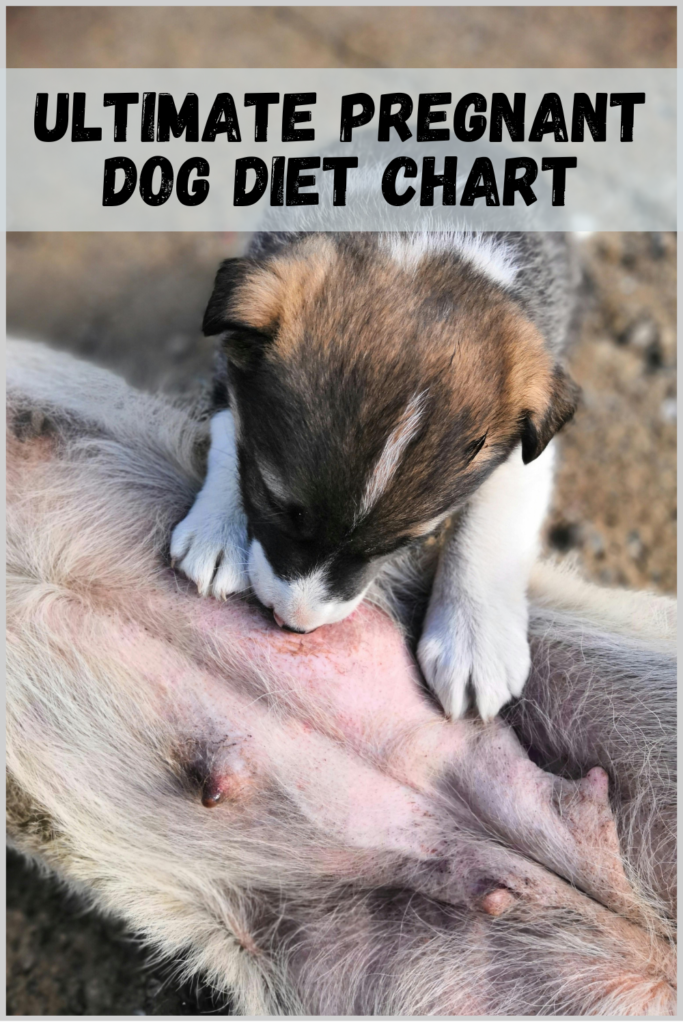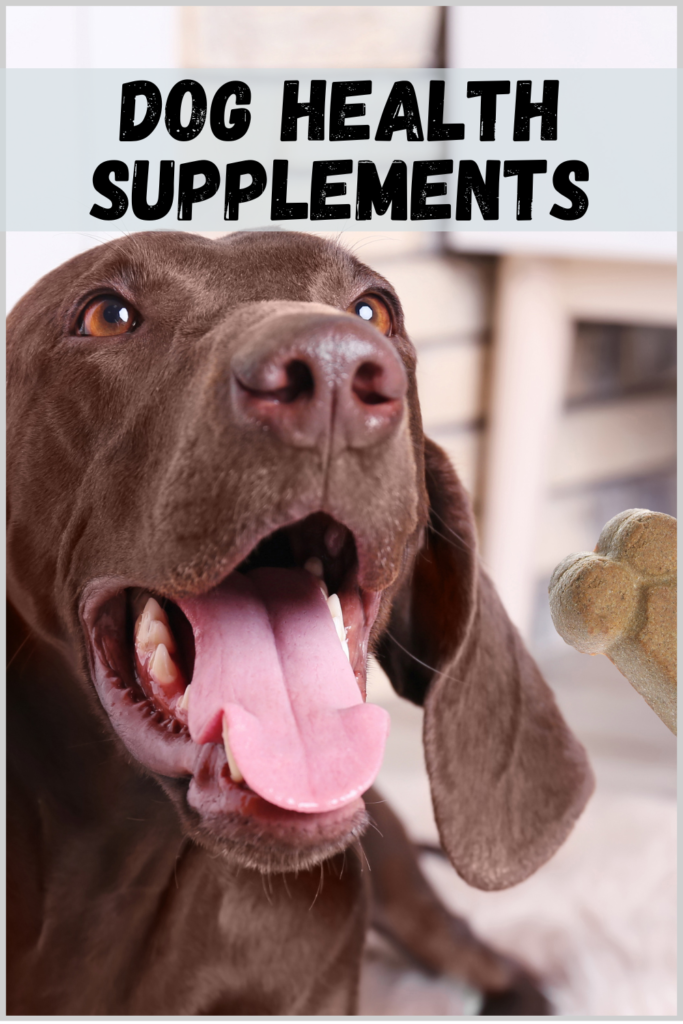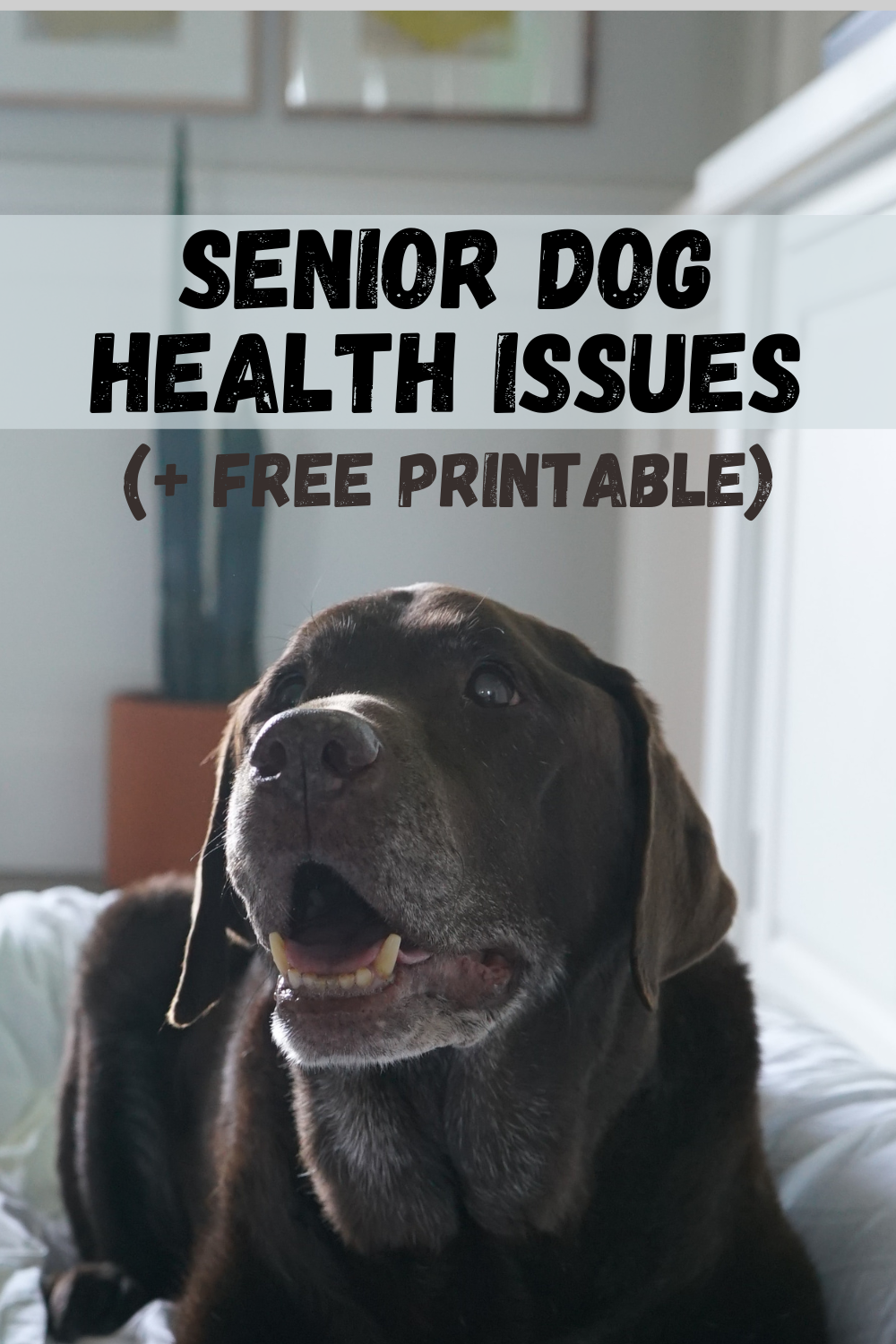
11 Senior Dog Health Issues, Symptoms & Next Steps
If you are a human and have a dog, you know that the lifecycle will continue and eventually come to an end. Your beloved pup, once so youthful, has become older… what does that mean for their health? What type of health issues can arise? There are many specific senior dog health issues, symptoms, and next steps to be aware of. Knowing the symptoms and what to do next (put into a handy printable chart!) to make sure you give your dog the best chance of a happy ongoing life with a greater quality of life.
As always, we strive to bring you up-to-date, research-based information on dog diet, health, and nutrition to give your best friend the long life they deserve.
Today, we’ll discuss the 11 most common senior dog health issues, along with their symptoms, so dog owners can be prepared and take action quickly!
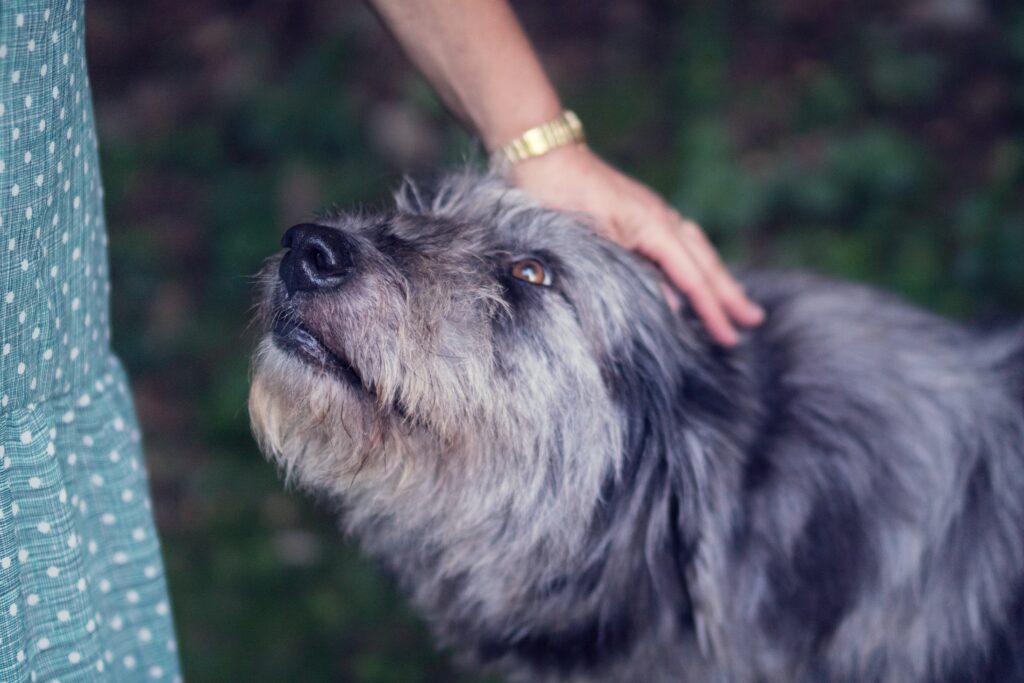
#1: Cancer
Unfortunately, cancer and malignant masses are common among senior dogs. There are many types, mostly random. There are many ways to prevent cancer, including both nutrition and lifestyle changes. Things like adding more antioxidants can help. One of the most common prevention measures is to spay/or neuter your dog. This severe reduces the chances of developing uterine, ovarian, or prostate cancer, as well as other beneficial factors.
If you notice any…
- lumps, bumps
- non-healing wounds
- vomiting, diarrhea
- lack of appetite
- difficulty doing any tasks like eating or urinating
Go see your vet to get bloodwork and testing done as soon as possible. If caught early, medicines and treatments will allow them to be treated fairly effectively, getting rid of the mass in the best-case scenario. Therefore, it is extremely important to visit your vet as soon as you notice any of the symptoms above.
#2: Heart Disease
Senior dogs are also more likely to develop heart failure as they age. Their heart becomes weaker and unable to pump blood well enough, which can eventually lead to Congestive Heart Failure (CHF). Look out for these symptoms, which can be signs of heart failure:
- Persistent Coughing
- Difficulty breathing
- shortness of breath
- Unwillingness or inability to exercise
- Fatigue, faster than normal
- Lack of appetite and weight loss
If you notice any of these signs, you will need to see a vet right away as well. They will put your dog on medication to help the blood get pumping again, so all tissues in their body are getting the necessary oxygen. This one will gradually worsen over time if not detected early. Even if you notice slight changes in their behavior, it is always good to go to the vet to get checked. Early detection is important!
#3: Arthritis
Arthritis is common among both humans and dogs because, over time, the joint tissue deteriorates. Through the years, our joint tissues tend to feel the full effect later in life. There are ways you can prevent the onset or prognosis, but there is no way to rid of arthritis completely. Once your dog has been diagnosed with arthritis, pain management or even surgery becomes the next steps.
If you notice any…
- Decreased activity and unwillingness to exercise or play
- Stiffness, especially after periods of rest
- Lameness or favoring one leg
- Changes to stance or gait (such as hunching over or ‘bunny hopping’)
- Reluctant to climb stairs or jump onto furniture
- Signs of pain, such as whimpering or flinching
Schedule an appointment to see your vet to get imaging done to confirm and treat accordingly.
For prevention and maintenance, the vet might recommend a joint supplement with glucosamine and chondroitin, along with pain medication. Both of these ingredients are proven to help with joint tissue and cartilage regrowth. Some of our favorites are Myos Joint and Muscle Formula or Fera Joint Powder, which you can put directly into your dog’s food.

#4: Urinary Tract Infections (UTI)
Just like us humans, dogs are not immune to the dreaded UTI. The feeling is absolutely terrible for everyone involved and can increase in senior female dogs.
Common symptoms are:
- Frequent accidents in the house
- Increased urination
- Difficulty urinating or straining
- Blood in urine (orange tinge)
If your dog has any of these symptoms, it is advised to go to the vet and get antibiotics. UTIs DO NOT go away on their own, and the earlier it is detected, the less pain for your furry friend. <3
#5: Incontinence
Incontinence means the inability to hold urine or bowel movements. Their bladder becomes weaker and unable to hold their urine in. Incontinence is more prevalent in females, and can really affect their quality of life.
Symptoms include:
- Straining to urinate
- Dribbling urine
- Wet patches on the floor and bedding
- Dampness on the fur around their hind legs
- Increased licking of their back end
- A persistent smell of urine
If you notice any of these symptoms, it is wise to go visit your vet who will offer some helpful tips. This might include putting diapers on your dog, daily cleanings, and more frequent walks and any medication that might help with controlling the bladder.
#6: Eye Cataracts and Blindness
Another common senior dog health issue is eye cataracts, which leads to blindness. Cataracts in dogs happen when their eye lens become more and more opaque. This means no light can pass through to the retina.
Specific symptoms include:
- Changes to the appearance of one or both eyes, such as cloudiness, grey or white spots
- Bumping into things
- Hesitation or anxiety when navigating new environments
- Avoiding stairs and jumping on or off furniture
- Becoming startled more easily when touched, particularly in a noisy environment
Unfortunately, there is not much we can do with cataracts if caught too late. If caught early, you can have it removed. Once it becomes more severe, all we can do is make sure we prepare them for this lifestyle change and assure them that everything will be okay.
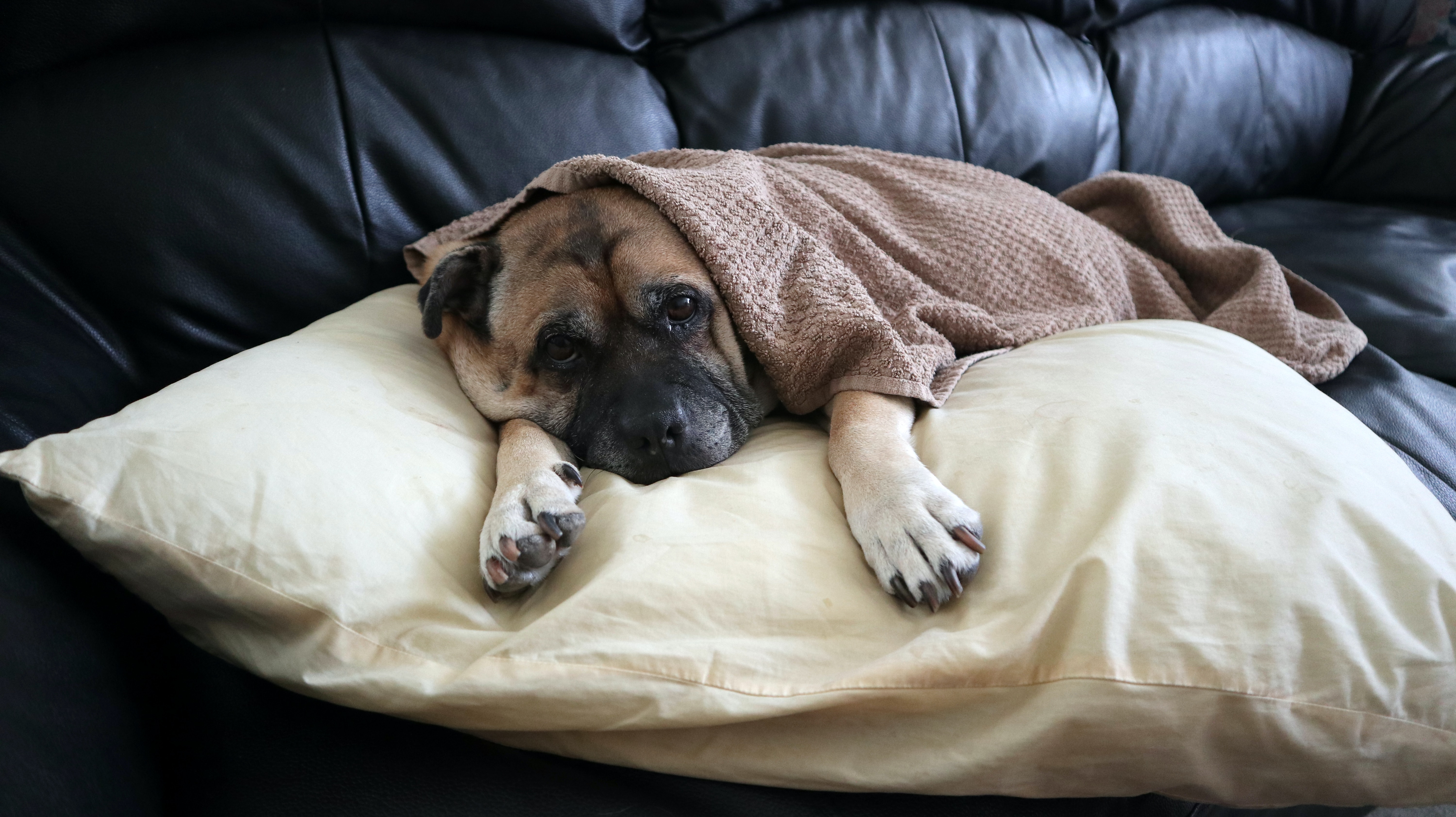
#7: Deafness
Deafness is another one that is both common and life-changing for your dog. If you notice your dog has these symptoms:
- Less responsive to commands / ‘ignoring you’
- Sleeping more soundly / through sounds that previously would have woken them up
- Becoming startled more easily
- More sensitive to strange sounds
- Other changes in behavior, such as snapping, anxiety, or aggression
Go see your vet to get this confirmed through performing some hearing tests. Unfortunately, there is not much we can do to stop this diagnosis and slow the progression. However, there are ways to help them transition, including teaching them different sign languages for common commands they know. Transitioning into hand commands and making your house more deaf-friendly can go a long way in making them feel better.
#8: Kidney Disease
Kidney disease occurs when the kidneys are no longer functioning as well, and toxins are not removed as easily. Some symptoms of kidney disease include:
- Increased thirst
- Increased urination, or conversely decreased urination
- Decreased appetite
- Weight loss
- Poor condition of fur (dull/lost shine, shaggy)
- Vomiting
Kidney disease, once diagnosed, can be managed with medication and common treatments like dialysis, depending on the severity of the diagnosis. As with most of these, the earlier detected the better.
#9: Obesity
Obesity is common among senior dogs because they tend to burn fewer calories compared to their caloric intake. They often do not exercise/play as often. Obesity, however, can also occur due to underlying issues.
Symptoms of obesity include visible weight gain, and not being able to feel the ribs. If your dog is standing, their body should have an hourglass figure. You should also be able to feel around their ribs and feel their ribs. If you cannot, there may be more fat around them than normal.
There are many options here, but first is to go to the vet to rule out any underlying issues. Any weight loss attempts will not be successful, if there is an underlying issue that needs to be addressed.
If all other health issues are ruled out, now is the time to create a weight loss diet plan. This will include decreasing their food intake gradually while also integrating exercise and other lifestyle changes. Slow and steady wins the race here, and will take 4-6 months of dedicated routine to see results. However, obesity if left untreated, can lead to a myriad of issues like cancer, diabetes, high blood pressure, and arthritis, to name a few! Obesity is often a precursor for many of the common senior dog health issues.

#10: Diabetes
Diabetes can develop often later in life as well. This is due to hormonal changes, where they can no longer produce insulin. After eating food, the body is not able to filter the sugar out.
Some symptoms include:
- Increased thirst
- Increased urination
- Increased hunger with weight loss
- Cataracts
- Weakness
- Recurrent infections (like urinary tract infections)
Visit your vet to get bloodwork to confirm the diagnoses. Fortunately, diabetes is very manageable with the right treatment regimen. However, prevention is important. Making sure your dog does not become overweight or obese is a big leading cause of your dog developing diabetes.
#11: Dental Issues
Many dental issues can arise throughout your dog’s life, but especially when they become older. Plaque and tartar build up over years that lead to periodontal disease (gum disease), and mouth pain, potentially affecting their eating.
This can be prevented with daily brushing from the start. This might be harder to implement now but if you notice any of the symptoms below, go visit your vet. They can and will do a professional teeth cleaning. Afterward would be the best time to start!
- Bad breath
- Difficulty chewing, favoring one side of the mouth, or unwillingness to eat
- Pawing at the mouth
- Excessive drooling, bleeding from the gums, or abnormal discharge
Though trying to brush your stubborn dog’s teeth sounds like a nightmare, especially if they’re not used to it, it is worth it. Try getting them used to your hands around their teeth first, then the toothbrush, and then brushing one side at a time. When starting out, you do not need to brush their whole mouth at once. Start small and do a little bit every day. Learn more about starting at-home grooming here!
Conclusion
There you go! 11 common senior dog health issues and symptoms to know. Just because we went through a few, does not mean this is an exhaustive list. Neither does it mean that your senior dog will have all of these issues above. The health problems listed above are meant to educate you on symptoms to look for, so you can be ready and most informed if anything does arise with your furry friend.
Here is everything discussed today into an easy printable with all of the health issues and symptoms for you to print/save and to have handy. Enjoy!


